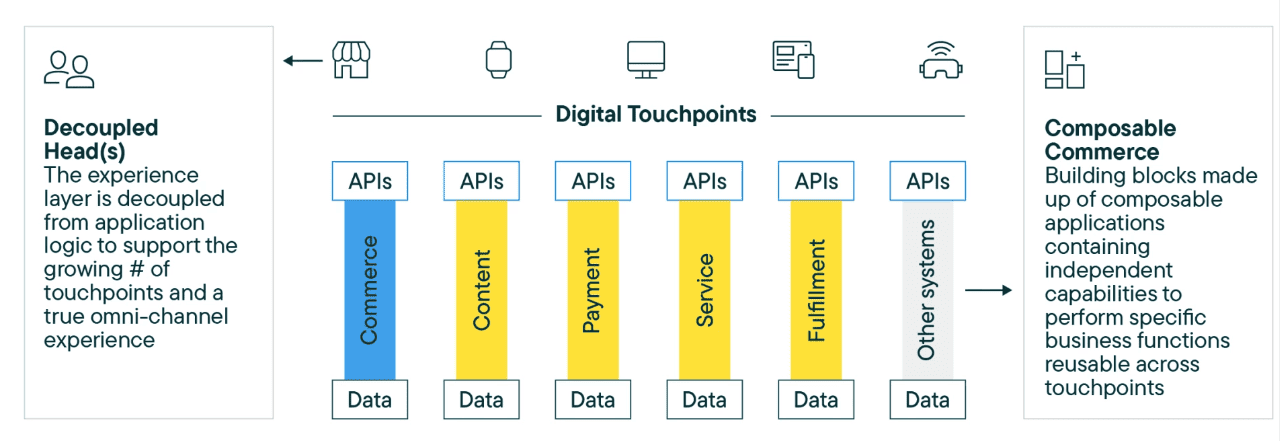Harness the Power of Composable Commerce and Take your Business to the Next Level

Written by Poonam Chandersy
Technical Content Writer
August 1, 2023
As digital commerce rapidly evolves, marketers must stay abreast of the latest industry developments. The retail landscape is changing at a faster pace than ever before with emerging technologies. To remain competitive in 2023 and beyond, you must understand how to compose your commerce strategy that leverages current advancements while enabling scalability and accuracy throughout each stage of the customer journey. In this blog, we’ll walk you through all the critical aspects of composable commerce to stay ahead of ever-increasing competition in online shopping.
What is Composable Commerce?
Composable Commerce is a modular and configurable approach to designing and maintaining eCommerce solutions with unprecedented freedom and flexibility. All the components can be deployed and scaled independently in a composable commerce architecture, allowing you to pick the components that offer the right capabilities for your business needs. The Packaged Business Capabilities (PBCs) act as building blocks and are connected through APIs for a seamless user experience. The main features of composable commerce include the following:
- Modular: With the ability to choose and customize best-of-breed solutions, you can pick the right technology for your business needs
- Flexible: Create, update, and personalize solutions with required components
- Open: Select commerce solutions that best suit your specific business needs
- Future-Proof: Customize your tech stack by exchanging components

Benefits of Composable Commerce
Customer Experiences
To meet customers’ seamless omnichannel expectations, businesses need flexible and agile frameworks. These frameworks help you efficiently manage multiple touchpoints, incorporate personalization tools, and offer tailored content that adapts to customers’ behaviours and preferences. For example, with composable commerce, you can effortlessly connect in-store and online experiences while integrating new touchpoints from IoT devices to social apps.
Internal Teams
With composable commerce, your internal teams can focus on creating value-driven solutions. Modular iterations allow you to include, remove, or swap functionalities effortlessly, reducing time to market for new products.
Brand Differentiation
With composable commerce, you can customize your stack with bespoke parameters that fit your unique brand requirements. Choosing a best-of-breed approach ensures that you’re giving your customers the ultimate shopping experience.
Implementing Composable Commerce
- Say No to Monolithic Architecture: Separating the presentation layer from your commerce platform allows you to innovate and create. However, it keeps business logic, workarounds, and integrations intact. Even though this is a temporary move, it is inexpensive and doesn’t result in upheavals.
- Moving from Monolithic to Composable: With this approach, you can redesign eCommerce solution and release it once complete. Until you move to a composable solution, the monolithic architecture remains. This process carries some risks and needs adequate planning to prevent errors.
- Segregating Migration: You can begin by transforming critical elements of monolithic architecture to enhance customer experience. This technique involves breaking monolith into smaller segments and gradually replacing them with single components. After some time, the monolith will fade away, freeing up space for more advanced technology.
Although it might take some time to comprehend the concept behind the new architecture, breaking down the process into phases allows you to try out individual segments and upgrade them as needed. In addition, this staged migration lets you effectively build your composable commerce architecture without significant disruptions or risks.
Offering Omnichannel Experiences with Composable Commerce
Consumers shop for products across different channels and devices. If a customer chose a product during their visit to a physical store but did not get the item in their preferred size or colour, they may then visit the store’s website to locate the desired product. Alternatively, they may like a product online and then go to the store to try and buy it. In a nutshell, consumers prefer to find and buy products from different touchpoints including social media channels, brick-and-mortar stores, and online storefronts.
This is a perfect example of how Composable Commerce assists businesses. Modular architecture enables businesses to include, modify, and remove touchpoints, ensuring device responsiveness. It also empowers them to personalize touchpoints to deliver cohesive shopping experiences.
The Future of Composable Commerce
According to research by Gartner, businesses that implement composable commerce will outrank their competitors by 80%. Thus, the scope of composable commerce is tremendous as businesses switch from monolithic systems to refine customer experiences, reduce costs, and amplify growth.
Conclusion
With the transformation of digital commerce, it is imperative to refine your eCommerce strategy to offer scalability and flexibility throughout the customer journey. Composable commerce empowers businesses to leverage modular components to overcome traditional restrictions and reap significant benefits. Royal Cyber’s experts can help you advance composable commerce to deliver exceptional experiences for your customers with a readily available Composable Commerce Accelerator for commercetools, which allows for swift implementation of B2C/B2B eCommerce solutions.
Recent Blogs
- An Insight into ServiceNow Hardware Asset Management (HAM) Ramya Priya Balasubramanian Practice Head ServiceNow Gain …Read More »
- Learn to write effective test cases. Master best practices, templates, and tips to enhance software …Read More »
- In today’s fast-paced digital landscape, seamless data integration is crucial for businessRead More »



